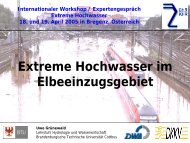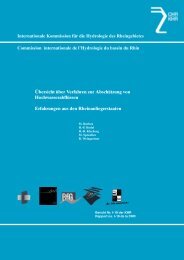ABSTRACTS 'Extreme Discharges' - CHR-KHR
ABSTRACTS 'Extreme Discharges' - CHR-KHR
ABSTRACTS 'Extreme Discharges' - CHR-KHR
Create successful ePaper yourself
Turn your PDF publications into a flip-book with our unique Google optimized e-Paper software.
One advantage of this approach is that each model can be optomized fully to the parameters for the given flow<br />
class without compromising other flow classes. On the other hand, it may give an extra weight to the calibration<br />
procedure possibly resulting in an over-parameterised (or over trained) model. There is also a danger that the<br />
model becomes very sensitive to the calibration procedure. Therefore, it needs a consistent and robust calibration<br />
procedure. An automatic calibration with manual intervention is proposed, which is described in following<br />
steps:<br />
(i) Establish initial values and minimum and maximum limits for each of the parameters obtained from<br />
available data and knowledge about the characteristics of the model domain (catchment).<br />
(ii) Finding of the optimum values for the parameters using automatic calibration procedures (with one<br />
or more algorithms and with one or more objective functions).<br />
(iii) Manually adjust the optimized parameter values using expert judgement.<br />
(iv) Re-adjust values of the parameters that are dependent on the values of the calibration parameters (if<br />
any); e.g. the feasible range of Muskingum x is dependent on the values of Muskingum K.<br />
(v) Evaluate the adjusted set of parameters by running the model. If the result is unsatisfactory:<br />
(vi) Re-adjust the parameter limits if necessary. For example, the automatic calibration may result in a<br />
parameter value close to its upper limit for all hydrological subunits, which means that the optimum value<br />
could be found at some higher value. If reasonable the upper limit of the parameter should be increased<br />
and the lower limit should be increased accordingly to narrow down the search space. Similar adjustment<br />
should be applied if the optimized parameter value is close to the lower limit.<br />
(vii) Check if some of the parameters have the most appropriate values in the current calibration run. If<br />
confirmed, fix the values for these parameters and exclude from further calibration. This helps to reduce<br />
the next calibration time.<br />
(viii) Repeat steps (ii) to (vii) until the satisfactory parameter set is found.<br />
The proposed calibration method possesses the advantages of both automatic and manual calibrations.<br />
Now<br />
Time<br />
Flow Precipitation<br />
Observed<br />
??<br />
Forecast<br />
??<br />
Now<br />
Time<br />
Figure 1: Role of future rainfall in flood forecasting.<br />
44





